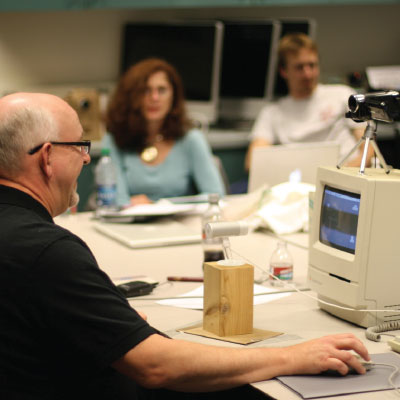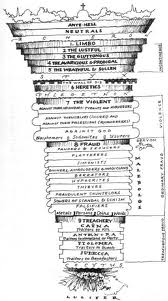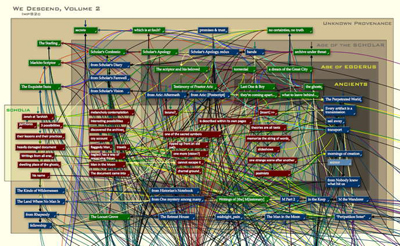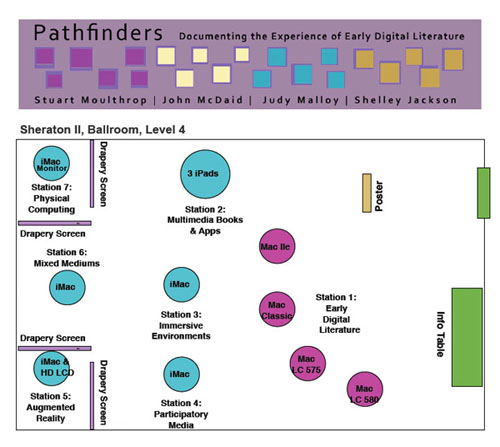We are pleased to have artist Judy Malloy guest writing a post for Pathfinders that lays out the timeline for the production for early Uncle Roger. Please join me in welcoming Judy.
—-

Judy Malloy, author of Uncle Roger with Dene Grigar (left) and Stuart Moulthrop (right).
1986
April 1986 – At Carl Loeffler’s invitation, I go online on Art Com Electronic Network (ACEN) on The Well (Whole Earth ‘Lectric Link).
August 1986 – I begin writing the text and designing the structure of File I of Uncle Roger: A Party in Woodside.
Fall 1986 – I begin programming A Party in Woodside in BASIC and create the authoring software BASIC Narrabase.
December 1 1986 – Using the BBS topic form as a story telling vehicle, I put A Party in Woodside online as a serial narrative on Art Com Electronic Network on The WELL. Keywords are included so that users can use any database software to create their own version of the work.
1987
January 29, 1987 – The telling of A Party in Woodside is completed on Art Com Electronic Network. I program A Party in Woodside with UNIX shell scripts, and ACEN publishes it online as an interactive hyperfiction on ACEN Datanet, which also published works by John Cage and Jim Rosenberg.
July 1987 – I begin telling The Blue Notebook, File 2 of Uncle Roger on Art Com Electronic Network. My essay, “Information as an Artists Material,” is published in Whole Earth Review no. 57:48-49, Winter, 1987. It includes Uncle Roger.
I create the first BASIC artists’ book disk version of A Party in Woodside, and this version is distributed by Art Com. The disk version of A Party in Woodside is exhibited at Ultimatum II, Exhibition, Images du Futur ’87, Montreal, Canada, Sept. 1987.
1987-1988 – I program The Blue Notebook with UNIX shell scripts with funding from The California Arts Council and Art Matters. The interactive version of The Blue Notebook is published online on ACEN Datanet.
1988
For file 3 of Uncle Roger, my authoring system Narrabase is expanded to include a generative function and implemented with both UNIX shell scripts and BASIC.
File 3 of Uncle Roger, Terminals, is published on ACEN Datanet as an interactive generative hypertext, programmed with UNIX shell scripts.
All three files of Uncle Roger are implemented in BASIC Narrabase, self-published on disk with packaging and documentation, and distributed internationally by Art Com.
Based on my Card Catalog HOME, (circa 1978) Molasses (for MacIntosh Computers/HyperCard), one of the first HyperCard hyperfictions, is produced at the Whole Earth Review under sponsorship of Apple and self-published in 1988 on disk with packaging.
Uncle Roger and Molasses are included in the traveling exhibition Art Com Software: Digital Concepts and Expressions, Tisch School of the Arts, New York University, NY, NY, Nov. 4 – 22, 1988. The show also traveled to San Jose State University, University of Colorado, Ars Electronica (Linz, Austria), and Carnegie Melon University. The show is reviewed by High Performance and Art Week.
I begin writing and programming its name was Penelope, based on the program for file 3 of Uncle Roger.
1989
The artist book version of its name was Penelope is implemented in BASIC Narrabase and exhibited at the Richmond Art Center in an installation with painted text on the wall and the work running on a computer. (See: Revealing Conversations, Richmond Art Center, CA, Oct. 3 – Nov. 19, 1989. Catalog)
A Party in Woodside is exhibited in ARTWARE at A Space, Toronto, Canada, April 6 – May 6, 1989.
Uncle Roger is listed as a new genre in the Wall Street Journal’s Centennial Issue. See Michael Miller, “A Brave New World: Streams of 1s and 0s” Wall Street Journal Centennial Issue, June 23, 1989.
1991
My essay, “Uncle Roger, an online narrabase” is published in Leonardo 24(2):195-202, 199, a special issue entitled “Connectivity: Art and Interactive Telecommunications” and edited by Roy Ascott and Carl Eugene Loeffler.










